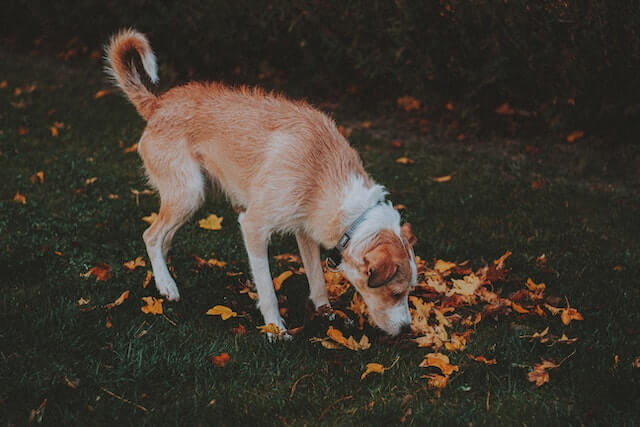The World of Scent Detection Dog Training: Unleashing the Power of the Nose

Dogs have an exceptional sense of Scent detection that far surpasses that of humans. While humans have around 5 million olfactory receptors in their noses, dogs have over 300 million. This remarkable ability to detect scents makes dogs valuable assets in a variety of fields, including law enforcement, search and rescue, and medical detection. In fact, dogs have been trained to detect everything from bombs and drugs to cancer and diabetes.
Scent detection is one of the most important and useful applications of a dog’s exceptional sense of smell. Dogs are able to detect and identify scents that are completely imperceptible to humans and have been trained to perform a wide range of scent detection tasks, including bomb detection, drug detection, search and rescue, and medical detection.

Scent Detection
Dogs are capable of detecting a wide range of scents and can be trained to detect specific scents for different purposes. Some of the scents that dogs can detect include:
- Explosives: Dogs can be trained to detect the smell of various types of explosives, including TNT, C4, and dynamite. These dogs are often used in law enforcement and military applications to search for bombs and other explosive devices.
- Drugs: Dogs can be trained to detect the smell of various types of drugs, including marijuana, cocaine, and heroin. These dogs are used by law enforcement agencies to search for illegal drugs and narcotics.
- Search and rescue: Dogs can be trained to detect the scent of a person, even if that person is buried under rubble or snow. These dogs are often used in search and rescue missions to locate missing persons.
- Medical detection: Dogs can be trained to detect the scent of various medical conditions, including cancer, diabetes, and seizures. These dogs are used in medical settings to alert their handlers to changes in a patient’s health.
Training Process for Scent Detection Dogs
Training a scent-detection dog is a complex and intensive process that requires careful planning, patience, and persistence. The training process typically involves several stages, including:
- Imprinting: During the imprinting stage, the dog is introduced to the scent it will be trained to detect. The dog is exposed to the scent in a controlled environment, such as a scent box, and is rewarded for indicating the location of the scent.
- Association: In the association stage, the dog is trained to associate the scent with a reward, such as food or a toy. The dog is taught to indicate the location of the scent by sitting or lying down in front of it.
- Discrimination: In the discrimination stage, the dog is taught to discriminate between the target scent and other scents. The dog is presented with a variety of scents and is rewarded only for indicating the location of the target scent.
- Generalization: In the generalization stage, the dog is trained to detect the target scent in a variety of environments and situations. The dog is trained to detect the scent in different locations, at different times of day, and in the presence of distractions.
- Maintenance: Once the dog has been trained to detect the target scent, it is important to maintain its skills. The dog must continue to receive regular training and practice in order to remain effective.

Different Fields in Which Scent Detection Dogs Are Utilized
Scent detection dogs are utilized in a variety of fields and industries, including:
- Law enforcement: Law enforcement agencies use scent detection dogs to search for bombs, drugs, and other illegal substances. These dogs are also used to track and apprehend suspects.
- Search and rescue: Scent detection dogs are used in search and rescue missions to locate missing persons. These dogs can locate a person even if they are buried under rubble or snow.
- Medical detection: Scent detection dogs are used in medical settings to detect changes in a patient’s health. For example, dogs have been trained to detect changes in blood sugar levels in patients with diabetes
- Agriculture: Scent detection dogs are used in agriculture to detect pests and diseases. These dogs can detect pests and diseases in crops and help prevent the spread of harmful organisms.
- Conservation: Scent detection dogs are used in conservation efforts to locate endangered species and their habitats. These dogs can detect the presence of species such as wolves, cougars, and bears, and help researchers track and study them.
- Environmental monitoring: Scent detection dogs are used in environmental monitoring to detect pollutants and other harmful substances. These dogs can detect the presence of pollutants in soil, water, and air, and help prevent environmental damage.
There are several safety products used in scent detection dog training, including:
- Protective gear for handlers: Handlers may wear protective gear such as gloves, arm sleeves, and bite suits to protect themselves from potential injuries during training.
- Safety vests for dogs: Dogs may wear safety vests during training to protect them from injury or to make them more visible.
- Leashes and harnesses: Leashes and harnesses are used to control and guide the dogs during training and to prevent them from running into dangerous areas.
- Muzzles: Muzzles are used to prevent dogs from biting or injuring themselves or others during training.
- First aid kits: First aid kits are essential in case of injuries or accidents during training.
- Safety barriers: Safety barriers such as fences, gates, and barricades may be used to prevent dogs from running into dangerous areas or to keep them separated from other dogs during training.

Overall, safety is a top priority in scent detection dog training, and trainers and handlers take all necessary precautions to ensure the safety of both the dogs and the humans involved.
There are several government organizations in the United States that provide scent-detection dog training, including:
- Transportation Security Administration (TSA): The TSA provides training for explosive detection dogs (EDD) and has a large number of EDD teams deployed at airports throughout the country.
- U.S. Customs and Border Protection (CBP): CBP provides training for dogs that are used in border protection and drug detection efforts.
- Federal Bureau of Investigation (FBI): The FBI provides training for dogs used in law enforcement and investigations, including bomb detection, search and rescue, and evidence recovery.
- Bureau of Alcohol, Tobacco, Firearms, and Explosives (ATF): The ATF provides training for dogs used in explosives detection, arson investigations, and firearms detection.
- U.S. Department of Agriculture (USDA): The USDA provides training for dogs used in agriculture, such as pest and disease detection in crops.
- U.S. Department of Defense (DOD): The DOD provides training for military working dogs used in a variety of roles, including explosives detection, patrol, and search and rescue.
Also Read Unleash the Potential of Lesser-Known Dog Sports In 2023
These organizations have highly trained and experienced trainers who work with dogs to develop their scent-detection skills and prepare them for their roles in various fields.
Scent detection dog training is not limited to government or law enforcement organizations in the United States. There are also many private companies and organizations that provide scent-detection training for civilian dogs.
One example is K9 Nose Work, which is a sport that was developed to provide scent detection training for pet dogs. K9 Nose Work focuses on teaching dogs to use their natural scenting abilities to locate hidden scents in various environments. The training involves teaching the dog to identify specific odors, search for the source of the odor, and communicate their findings to their handler.
Other private companies that provide scent detection training for civilian dogs include:
- Working K9 Academy: This company provides scent detection training for dogs in a variety of fields, including drug and bomb detection, as well as search and rescue.
- High Drive K9: High Drive K9 provides scent detection training for dogs in law enforcement, as well as private security and investigation firms.
- Scent Work University: This online training program offers courses in scent detection for pet dogs, as well as training for dog trainers who want to specialize in scent work.
- Dogs Finding Dogs: This organization provides search and rescue training for pet dogs to assist in locating lost pets.
These private companies and organizations use positive reinforcement training methods to develop a dog’s natural scent detection abilities and offer training for a variety of different scent detection applications.
Many of these companies also offer certification programs for dogs who complete their training, which can be useful for demonstrating the dog’s abilities to potential employers or clients.
Conclusion
Scent detection dog training is a fascinating and complex field, with a wide range of applications and uses. Dogs have an exceptional sense of smell and are capable of detecting scents that are completely imperceptible to humans.
The training process for scent detection dogs is intensive and requires careful planning, patience, and persistence. Once trained, scent detection dogs are utilized in a variety of fields and industries, including law enforcement, search and rescue, medical detection, agriculture, conservation, and environmental monitoring.
Overall, scent-detection dogs play an important role in many areas of our lives, and their exceptional abilities continue to amaze and inspire us.
Check Out Take Care Of Your Pet With Emergency Pet Information Sheet 2023
Disclaimer: This article may contain affiliate links to products. All product details reflect the price and availability at the time of publication. We may receive a commission for purchases made through these links.



